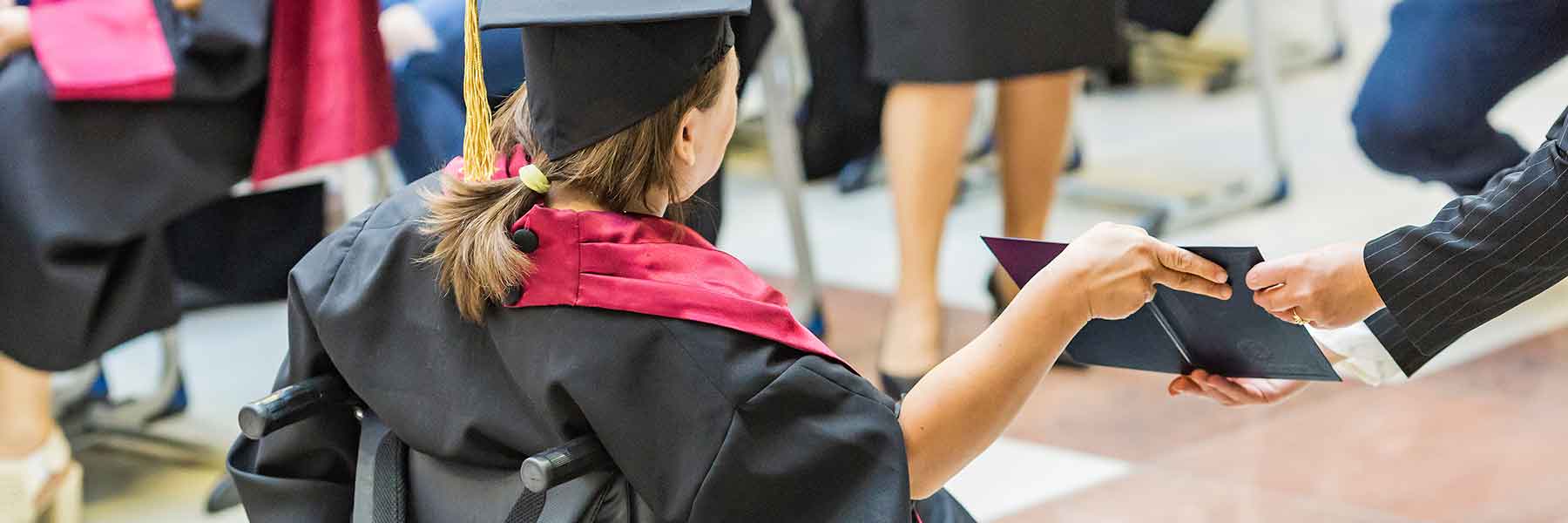- Do not pet a service animal; petting a service animal when the animal is working distracts the animal from its job and purpose.
- Do not feed a service animal. The service animal may have specific dietary requirements.
- Do not deliberately startle, taunt, disturb, or pester a service animal.
- Do not separate or attempt to separate a partner from his/her service animal.
- Avoid initiating conversations about the student's disability or the service animal. All disabilities are not visible. Be aware that some people do not like to discuss their disability.
Please be respectful of these guidelines. Failure to comply with proper Service Animal Etiquette may result in harm to both the service animal and the partner. Remember, service animals are working animals and not pets. They serve to allow individuals with disabilities equal access to IU Southeast facilities and programs.
Person with a Disability
A person is considered as having a disability under the Americans with Disabilities Act if they have “a physical or mental impairment that substantially limits one or more major life activities."
Partner
A person with a service animal. A person with a disability is called a partner.
Handler
A person who trains a service animal is referred to as a handler.
Service Animal
Animals trained to assist people with disabilities in the activities of daily living. The Americans with Disabilities Act (ADA) definition of service animal is “…any…animal individually trained to do work or perform tasks for the benefit of an individual with a disability, including, but not limited to, guiding individuals with impaired vision, alerting individuals who are hearing impaired to intruders or sounds, providing minimal protection or rescue work, pulling a wheelchair, or fetching dropped items.” If an animal meets this definition, it is considered a service animal regardless of whether it has been licensed or certified by a state or local government or a training program.
Guide Dog
A Guide Dog is a carefully trained dog that serves as a travel tool by persons with severe visual impairments or who are blind.
Hearing Dog
A Hearing Dog is a dog who has been trained to alert a person with significant hearing loss or who is deaf when a sound, e.g., knock on the door, occurs.
Assistance Dog
An Assistance Dog is a dog that has been trained to assist a person who has a mobility or health impairment. Types of duties the dog may perform include carrying, fetching, opening doors, ringing doorbells, activating elevator buttons, steadying a person while walking, helping a person up after the person falls, etc.
Seizure Response & Alert Dog
A Seizure Response & Alert Dog is a dog trained to assist a person with a seizure disorder; how the dog serves the person depends on the person's needs. The dog may stand guard over the person during a seizure, or the dog may go for help. Some dogs are able to predict a seizure and warn the person in advance.
“The Code of Ordinances for the City of New Albany requires that all animals be licensed. Adult licenses shall be valid for one year from date of issue. The license fee shall be waived for certified Seeing Eye Dogs, hearing dogs, governmental police dogs, or other certified dogs that are trained to assist the physically handicapped. These shall still be registered with the Department of Animal Control and must obtain a license as any other. It shall be unlawful to keep any animal unless that animal has been inoculated against rabies by a licensed veterinarian within the preceding year. No license tag shall be issued for any animal without proof of inoculation.”
- A student who uses a service animal shall register the animal with the Coordinator of Disability Services, prior to attending classes. A copy of current vaccinations and license must be provided each year. Employees should contact Human Resources.
- The partner/handler is encouraged to carry identification, indicating the animal is a service animal.
- Service animals shall be restrained on a lead or short leash (approx. 4 feet long) at all times. Exceptions will be made if the animal is working, and if the partner cannot physically hold a leash or a lead.
- The partner/handler must be in full control of the animal at all times.
- Service animals shall not be disruptive (e.g., barking inside a building).
- Service animals shall not be left unattended.
- The care and supervision of a service animal is solely the responsibility of its partner/handler. This includes proper grooming, as well as flea, tick, and odor control.
- The partner/handler shall dispose of all animal waste. It is the partner’s responsibility to be aware of the animal’s need to relieve itself and act accordingly.
- The partner/handler is responsible for all damages and/or injuries caused by the animal.
- A guest/visitor to campus is encouraged to notify the Coordinator of Disability Services of the presence of the service animal and the duration of visit.
The University may prohibit the use of service animals in certain locations due to health or safety restrictions, where service animals may be in danger, or where their use may compromise the integrity of research, e.g., work in the Life Sciences. Such restricted locations may include, but are not limited to, the following areas:
- Research laboratories
- Classrooms with demonstration/research animals
- Custodial closets
- Nuclear research areas
Exceptions to restricted areas may be granted on a case-by-case basis by contacting the Coordinator of Disability Services and the appropriate department and/or laboratory representative. However, the person directing the work in the restricted area will make the final decision based on the nature of the research and the best interest of the service animal.


